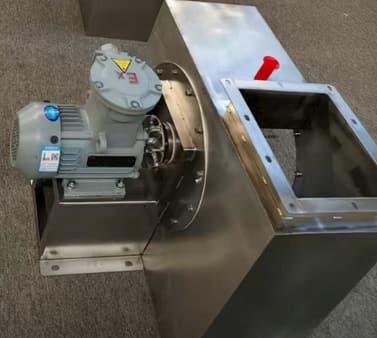Centrifugal Impeller Produces Much More Static Pressure Than Axial Impeller
When we compare only the rotating impellers (no volute, no diffuser, no housing), a centrifugal impeller inherently has a much stronger ability to generate static pressure than a typical axial impeller. The reason is fundamental: centrifugal geometry accelerates air radially and creates conditions for converting kinetic energy into static pressure, whereas axial impellers primarily impart axial velocity (dynamic pressure) to the flow.


Axial vs Radial Motion
An axial impeller is designed so air flows largely parallel to the rotation axis: the blades work like wings to push a column of air forward, producing high volumetric flow (CFM) at relatively low static pressure. By contrast, a centrifugal impeller pulls air into the eye and flings it outward along the radius; that radial acceleration of fluid is the core mechanism that can produce higher pressure rise per stage. In short: axial → velocity-dominant; centrifugal → radial-acceleration that enables pressure rise.
How the impeller itself converts energy (kinetic → static)
Inside a centrifugal impeller the air is given angular momentum and a high peripheral (tip) velocity. As air moves from the hub to the rim it gains radial velocity and kinetic energy; when that fast-moving air decelerates (either inside the blade passages or immediately after the rim), much of the kinetic energy can convert into static pressure. Even without a volute, the radial fling + flow deceleration inside the blade passages produces a notable static pressure increment compared with the mostly axial acceleration in an axial impeller.
Blade geometry and relative velocity
Centrifugal impeller blades are typically backward-curved or radial with a widening passage toward the outlet; that geometry makes the relative velocity decrease through the passage (a diffuser effect) and so encourages kinetic→static conversion. Axial blades are optimized to keep flow aligned and minimize separation — they do generate lift (therefore velocity) but have limited capacity to increase static head without stalling. The blade inlet/outlet angles, chord, and camber set how much energy is transferred and whether it ends up as velocity or static pressure.
What happens if you remove the housing (volute/diffuser)?
A common question: 'If the outer casing is removed, can the centrifugal impeller still generate high static pressure on its own?' — yes, but less efficiently. The impeller alone still creates radial momentum and locally elevated static pressure at the rim because of centrifugal acceleration and blade-relative slowing, but the smooth conversion of velocity to useful static pressure normally benefits greatly from a downstream diffuser or volute. Without housing the recovered static pressure and directionality will be poorer, but the basic mechanism making centrifugal impellers capable of higher static pressure still exists in the blade geometry itself.
Why centrifugal pressure often outpaces axial pressure
Fan theory (the affinity/fan laws) tells us pressure scales with speed² and with blade tip velocity. For a centrifugal impeller the effective tip radius combines with rotational speed to produce large peripheral velocities — so the available energy to raise pressure grows quickly with speed and diameter. Axial fans can also increase pressure with speed, but their configuration is limited by blade loading, stall, and the need to keep flow attached; centrifugal geometry tolerates higher energy densities before severe separation occurs.
Practical viewpoint
In practice, you commonly see axial impellers used where volumes are large and required static pressure is low (e.g., large open-air cooling, wind tunnels), while centrifugal impellers are chosen when ducts, filters, or long runs require hundreds to thousands of Pascals of static pressure. Even as a bare rotor, a centrifugal wheel will show a pressure-rise curve shifted toward higher static pressures compared to a similarly sized axial wheel at comparable speed.
If a project needs high static head in a compact axial-length envelope, consider a centrifugal or mixed geometry impeller — even if space precludes a full volute, the impeller’s radial acceleration gives you the pressure head you cannot obtain from an axial wheel without multiple stages or impractically large diameters. Always verify with measured fan curves for the exact rotor at intended speed and under anticipated inlet conditions — theory guides selection, but test data confirm reality.
Note: The content of the article cannot avoid omissions and errors. Welcome to propose corrections.
 Mancooler (Workstation) Fans — Why Your Factory Needs the Right One
Mancooler (Workstation) Fans — Why Your Factory Needs the Right One
 Motor Classifications in Industrial Fans
Motor Classifications in Industrial Fans
 Materials for Explosion-Proof Fan
Materials for Explosion-Proof Fan
 Direct Drive vs. Belt Drive in Axial Fan and Centrifugal Fan
Direct Drive vs. Belt Drive in Axial Fan and Centrifugal Fan

